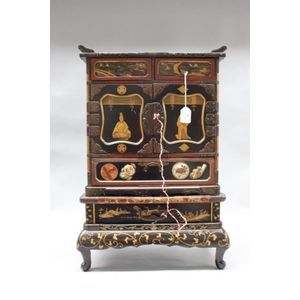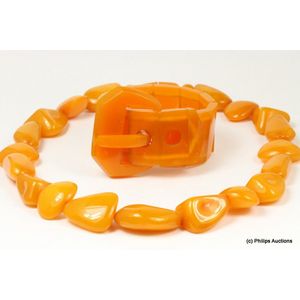Bakelite Amber Beads & Panel Bracelet Set
You must be a subscriber, and be logged in to view price and dealer details.
Subscribe Now to view actual auction price for this item
When you subscribe, you have the option of setting the currency in which to display prices to $Au, $US, $NZ or Stg.
- Bakelite - Bakelite was the first completely synthetic man-made substance. Bakelite was invented in 1909 by an independent New York chemist Leo H. Baekeland. It was called the "material of a thousand uses" and used to make everything from car parts to jewellery.
Although nearly all plastic from this period is known as ?Bakelite', it is important to remember that this is an umbrella term that covers many different early plastics such as Lucite and cellulose acetate, and includes Bakelite.
We often think of the colour of Bakelite items as dark brown, but it was manufactured in various colours including yellow, butterscotch, red, green and brown.
Bakelite could also be transparent, or marbleised by mixing two colours. Plastics were cheap to produce and could be moulded or carved in a huge variety of ways.
Bakelite is most commonly associated with radio cases of the 1930s, telephones and kitchen utensils, but it was also used extensively in jewellery manufacture.
Early designs from the 1920s were plainer and simpler than later examples. Geometric and floral patterns typical of Art Deco styling were popular.
During its heyday in the 1930s, Bakelite jewellery was stocked by the most prestigious stores, such as Saks, Harrods and Macy?s, who dedicated a shop window display to it in 1935.
Coco Chanel featured Bakelite items in her accessories collection and the material was praised frequently in Vogue magazine.
Manufacture of some consumer Items were suspended in 1942 in order to concentrate manufacturing on the war effort.
Small items made of Bakelite are now valuable collectables. Andy Warhol was an avid collector, and when he died in 1987, his pieces sold for record prices at Sotheby's. - Amber - More frequently used to refer to the colour, than the material from which the word is derived, amber is the fossilized resin from ancient forests. It is not produced from tree sap, but rather from plant resin. The resin is aromatic, and can drip from and ooze down trees. In colour, it may be a deep honey colour, (amber), brown, or white. As it oozes out it fills internal fissures in the tree, trapping debris such as seeds, leaves, feathers and insects. The debris trapped within the amber can assist in dating the deposit.
In its natural state it is found in rocks, on the sea floor (from where it may be washed up to the shore) and mined, using both open cut and underground techniques. About 90% of the world's amber comes from Russia. Amber has recently been discovered at Cape York in Northern Australia
Amber is often incorporated in jewellery, and used in pipe stems. The shine on the surface of amber becomes even more intense when it is worn and used regularly. Genuine amber, when rubbed, will release a slightly musky scent.
This item has been included into following indexes:
Visually similar items

A primitive oak and elm elbow chair, English, 18th century

A pair of diamond ear studs, four claw set with modern brilliant cut diamonds of total estimated weight 0.56 carat. 14ct white gold. Weight 0.95 grams. Post and butterfly attachments

Fine antique Japanese multi drawer table cabinet, has key, approx 62 cm high, 42 cm wide, 25 cm deep

Japanese Satsuma vase. Ladies in garden decoration. Red mark to base.
